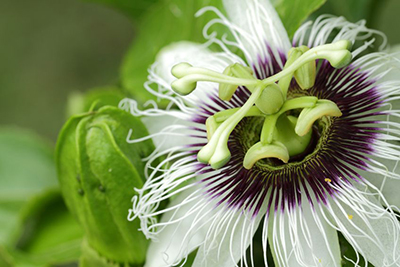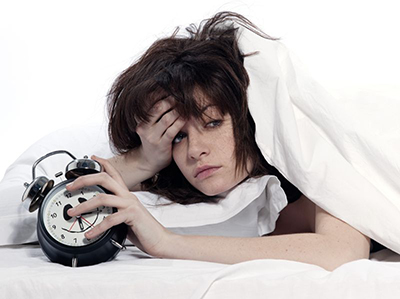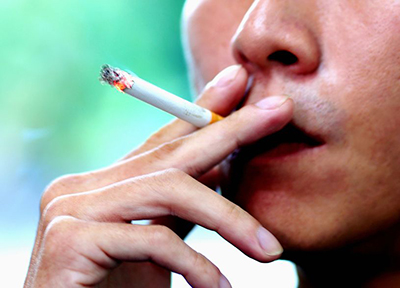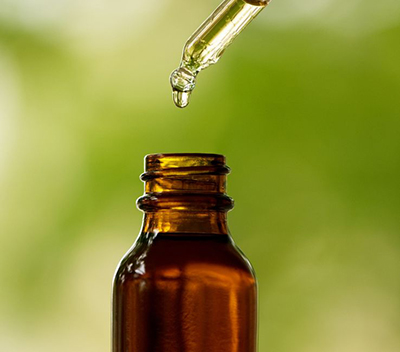Passionflower: Plant Medicine for Anxiety, Insomnia, and Addiction
 Passionflower and Anxiety
Passionflower and Anxiety
The beautiful purple passionflower is renowned as an ornamental flower, but it has been touted as an effective herbal medicine in cultures around the globe for centuries.[1] The Aztecs of Mexico and South America used passionflower as a sedative and nerve tonic, a use which the Spanish conquistadors took back to Europe, where use of passionflower has flourished.[2] This article will focus on the use of passionflower for neurological concerns — specifically anxiety, insomnia, and addiction. An overview of the appropriate use of passionflower, dosing, and use in special populations will conclude our discussion of this stunning botanical.
Anxiety disorders, such as generalized anxiety disorder (GAD), panic disorder, obsessive-compulsive disorder, and post-traumatic stress disorder, are the most common mental health problems seen by doctors.[3] Over half of people with anxiety disorders seek relief from complementary and alternative therapies including relaxation techniques, homeopathy, and botanical medicines.[4]
In the treatment of generalized anxiety disorder, passionflower has been found to be as effective as oxazepam (a benzodiazepine). In a ground-breaking study, researchers found that over four weeks, both passionflower and oxazepam were equally effective in managing symptoms of anxiety. Passionflower was considered to be superior as a therapy compared to the oxazepam because of a lower incidence of negative side effects, primarily impairment of job performance.[5]
Studies of patients undergoing anxiety-provoking surgical procedures have also demonstrated the anti-anxiety effects of passionflower. Patients undergoing surgery to repair hernias had decreased anxiety scores 10 minutes and 30 minutes after receiving a single oral dose of passionflower. They experienced no sedative side effects, which is an important consideration in a presurgical situation.[6] Similar anti-anxiety effects were seen in a study using passionflower prior to spinal anesthesia, again with no increase in sedation.[7]
Emerging research points to a potential mechanism of action for the anxiety-reducing effects of passionflower. The neurotransmitter gamma-aminobutyric acid (GABA) has been implicated in the progression of anxiety disorders and has been the focus of pharmaceutical treatments such as the benzodiazepine drugs.[3, 8] Animal studies have shown that passionflower is able to bind to GABA receptors and modulate the action of this calming neurotransmitter.[1, 9–12] This may be due to the GABA content of passionflower, the highest level of 21 plants tested,[13] or due to another compound found in passionflower such as the bioflavonoid chrysin.[9]
In contract to benzodiazepines, passionflower does not have the negative side effect profile association with both short- and long-term use. Benzodiazepines can lead to significant daytime sedation and confusion, and have been associated with withdrawal symptoms after sudden discontinuation.[3] The Food and Drug Administration classifies passionflower as “generally regarded as safe,” and studies of passionflower in humans find it to be well-tolerated and without significant side effects such as drowsiness or motor impairment.[2]
Passionflower offers an important alternative in the treatment of anxiety disorders, a condition for which many people are seeking non-pharmaceutical treatment options. Further research is warranted, but traditional use and preliminary studies are overwhelmingly positive.
 Passionflower and Insomnia
Passionflower and Insomnia
Insomnia is a major health concern in our modern society. With between 10% and 15% of adults, and a similar percentage of teens, experiencing sleep disturbances, it is one of the most common conditions presented to both primary care physicians and specialists.[14][15] Traditional herbalists have a wide variety of choices for the management of insomnia. Passionflower is listed in the German Commission E for the treatment of insomnia and nervous restlessness,[16] and was approved in the United States as an over-the-counter sedative until 1978.[17]
Sleep is a complex interplay of hormones, neurotransmitters, and circadian rhythms in the brain.[18] Insomnia is an equally complex process, with many potential causes and associated medical conditions. Insomnia is a common finding in people suffering from both anxiety and depression, and many of the treatments for these conditions are being explored for their potential to treat insomnia.
gamma-Aminobutyric acid (GABA) is the most common inhibitory (calming) neurotransmitter in the brain and is a primary target for many sleep-inducing agents. By inducing production of GABA or by binding the GABA receptors, the hyperarousal state of insomnia can be lessened and sleep can occur. The primary class of medications that interact with GABA in the brain are benzodiazepines. They have been found to decrease time to initiate sleep and enhance sleep quality.[14] However, use of benzodiazepines for sleep dysfunction is not ideal, due to associations with development of tolerance, abuse potential, morning-after sedation, and cognitive impairment.[19] Rebound insomnia, anxiety, and irritability are all common symptoms associated with abrupt discontinuation of benzodiazepines.[14]
Passionflower offers a way to impact the GABA receptor in the brain and enhance sleep without the negative side effects or development of tolerance. GABA is a prominent ingredient in the aerial parts of the passionflower plant. Not only does passionflower contain a high amount of GABA, but it is also able to bind to GABA receptors and lead to a suppression of the hyperarousal state associated with insomnia.[20]
Few studies have been performed assessing passionflower for insomnia specifically. One Australian study found that one cup of passionflower tea nightly significantly improved sleep quality compared to placebo, but did not alter sleep latency (time to fall asleep). The authors suggest that the lack of effect may be due to the low dose (one cup vs. the standard dose of 3 cups).[21]
Traditional herbalists suggest that passionflower is best indicated for relief of insomnia associated with nervous restlessness, anxiety, or over-active mind preventing initiation of sleep.[22] The impact that passionflower exhibits on the GABA system of the brain suggests it holds promise as a non-addictive support for individuals with insomnia, without the residual morning sedation associated with benzodiazepines.
 Passionflower in Addiction / Substance Withdrawal
Passionflower in Addiction / Substance Withdrawal
Addiction to alcohol, cigarettes, opiates, marijuana, and prescription and recreational drugs has impacts beyond the physical damage they do to the body; there are far-reaching implications for families and communities as well.[23] Treatment of addiction is an important goal for the health of both individuals and society, and requires a multifaceted approach for success.
Treatment of addiction begins with detoxification. In this step, drug ingestion is stopped and the body no longer receives the addicted substance. This step leads directly to withdrawal. Withdrawal is the acute post-drug-taking illness, and typically produces an intense variety of symptoms.[24] Withdrawal symptoms can include tremors, irritability, nausea, insomnia, high blood pressure, sweating, severe anxiety, depression, and potentially seizures.[25] Once the symptoms of withdrawal subside, lifestyle and psychiatric counseling are necessary to prevent relapse.
Passionflower is demonstrating considerable promise in the treatment of the detoxification and withdrawal phases of addiction treatment. As a non-addictive natural therapy, passionflower offers a safe alternative to some of the pharmaceuticals currently used for this purpose.
A 2001 controlled trial of passionflower in the treatment of opiate (heroin) withdrawal found that combining passionflower with the standard pharmaceutical treatment (clonidine) significantly decreased withdrawal symptoms such as nausea, convulsions, anxiety, and tremor, compared to clonidine alone.[26]
Animal studies have found that a constituent of passionflower decreased the intensity and severity of withdrawal symptoms associated with detoxification from nicotine. This study also found that passionflower prevented weight loss associated with withdrawal, a measure of stress or depression in animals.[27]
The benzoflavone moiety of passionflower has also been used in animal studies of alcohol detoxification. In both acute and chronic administration, passionflower significantly decreased the expression of withdrawal effects and anxiety behavior.[25]
Marijuana addiction is another substance-abuse problem that may respond to passionflower. A compound isolated from passionflower, when administered with cannabinoids, prevented the development of tolerance and dependence of cannibinoids in mice. Administration of the passionflower extract also decreased expression of withdrawal effects and countered the drug-induced sexual decline associated with the use of marijuana.[28]
The use of passionflower as an integrative therapy during addiction treatment is promising, based on preliminary animal studies. The non-addictive potential of passionflower and the low potential for interaction with pharmaceutical treatments make passionflower an ideal addition to the integrative care of addiction, and further research should be encouraged.
Passionflower has great potential in the treatment of diverse health concerns including anxiety, insomnia, and addiction.
 Passionflower: Dosage and Safety Considerations
Passionflower: Dosage and Safety Considerations
Passionflower is more than an ornamental flower; it is a botanical medicine with a long history and potential for a flourishing future.
The Passiflora family contains more than 500 different plants.[29] The species that has been found to have the greatest medical potential is Passiflora incarnata Linnaeus.[30] For anti-anxiety purposes only, the aerial portions of the passionflower plant should be used. The roots of the passionflower plant have no anti-anxiety effect. The leaves and stems are the most potent, and an ideal passionflower product will contain only these parts.[31] Products that contain the whole plant may require higher doses for therapeutic effects.
Passionflower contains many different active constituents, including alkaloids and flavonoids,[32] and gamma-aminobutyric acid (GABA).[33] While there is considerable speculation as to which compound is responsible for the action of the passionflower (chrysin, GABA, passiflorine, benzoflavone moiety), it is advisable to assume a synergistic effect of all the compounds as being ultimately responsible for the medicinal actions of this plant.[30][31][33][34][35]
A study of the anti-anxiety effects of passionflower found that only the methanol-extracted plant exhibited anxiolytic effects.[31] For anxiety, a methanol-extracted tincture or supplement may be considered superior, while a water-based extract (tea or infusion) is less likely to be effective.
Dosing of passionflower is dependent on the desired effect.
Table 1. Suggested Doses for Passionflower
|
Indication |
Dose of passionflower |
Comments |
|
Anxiety |
1–4 ml tincture (aerial parts only) two to three times daily |
A higher dose may be necessary if the whole plant extract is used |
|
Insomnia |
1–4 ml tincture (aerial parts only) in evening before bed 1 teaspoon dried herb (aerial parts only) infused in hot water one to three cups nightly |
High dose of the infusion may disrupt sleep due to need to urinate |
|
Addiction |
1–4 ml tincture (aerial parts only) two to four times daily |
A specific dosage range in humans has not been established. One study used 1 ml three times daily with clonidine for heroin withdrawal [36] |
Safety Considerations
Passionflower is classified as “generally regarded as safe” (GRAS) by the Food and Drug Administration. Passionflower does not interact with most medications. Theoretically, it could interact with medications and supplements with sedative properties, and enhance their effects and potential side effects.[37]
Special Populations
Passionflower may be unsafe during pregnancy due to potential uterine-stimulating effects of some passionflower constituents.[37] Many herbalists consider it safe during pregnancy, but caution is recommended.
Passionflower is safe for use in children and adolescents at age-appropriate doses.[38] Passionflower is also safe for use in the elderly, and may be a better choice than benzodiazepines, which have an increased risk of falls in the elderly.[39]
In conclusion, we find that passionflower is an incredibly safe herb, with great therapeutic potential for treating multiple nervous system impairments, specifically anxiety, insomnia, and addiction. The ability to use passionflower in diverse populations and integratively with pharmaceutical medications makes this botanical medicine a valuable treatment option for three prevalent health concerns.
References
- Appell, K., et al. “Modulation of the gamma-aminobutric acid (GABA) system by Passiflora incarnata L.” Phytotherapy Research Vol. 25, No. 6 (2011): 838–843.
- Traub, M. “Passionflower (Passiflora): An overview of the research and clinical indications.” Available from: http://www.integrativemedicalinitiatives.com/imsp/presentations-2012-2013/a_research_review_of_passio.pdf
- Kavan, M.G., G. Elsasser, and E.J. Barone. “Generalized anxiety disorder: Practical assessment and management.” American Family Physician Vol. 79, No. 9 (2009): 785–791.
- Kessler, R.C., et al. “The use of complementary and alternative therapies to treat anxiety and depression in the United States.” The American Journal of Psychiatry Vol. 158, No. 2 (2001): 289–294.
- Akhondzadeh, S., et al. “Passionflower in the treatment of generalized anxiety: a pilot double-blind randomized controlled trial with oxazepam.” Journal of Clinical Pharmacy and Therapeutics Vol. 26, No. 5 (2001): 363–367.
- Movafegh, A., et al. “Preoperative oral Passiflora incarnata reduces anxiety in ambulatory surgery patients: A double-blind, placebo-controlled study.” Anesthesia and Analgesia Vol. 106, No. 6 (2008): 1728–1732.
- Aslanargun, P., et al. “Passiflora incarnata Linneaus as an anxiolytic before spinal anesthesia.” Journal of Anesthesia Vol. 26, No. 1 (2012): 39–44.
- Larzelere, M.M., J.S. Campbell, and M. Robertson. “Complementary and alternative medicine usage for behavioral health indications.” Primary Care Vol. 37, No. 2 (2010): 213–236.
- Brown, E., et al. “Evaluation of the anxiolytic effects of chrysin: A Passiflora incarnata extract, in the laboratory rat.” AANA Journal Vol. 75, No. 5 (2007): 333–337.
- Elsas, S.M., et al. “Passiflora incarnata L. (Passionflower) extracts elicit GABA currents in hippocampal neurons in vitro, and show anxiogenic and anticonvulsant effects in vivo, varying with extraction method.” Phytomedicine Vol. 17, No. 12 (2010): 940–949.
- Dhawan, K., S. Dhawan, and S. Chhbara. “Attenuation of benzodiazpeine dependence in mice by a tri-substituted benzoflavone moiety of Passiflora incarnata Linnaeaus: A non-habit forming anxiolytic.” Journal of Pharmacy & Pharmaceutical Sciences Vol. 6, No. 2 (2003): 215–222.
- Dhawan, K., S. Kumar, and A. Sharma. “Anxiolytic activity of aerial and underground parts of Passiflora incarnata.” Fitoterapia Vol. 72, No. 8 (2001): 922–926.
- Carratu, B., et al. “Free amino acids in botanicals and botanical preparations.” Journal of Food Science Vol. 73, No. 5 (2008): C323–C328.
- Sullivan, S.S. “Insomnia pharmacology.” The Medical Clinics of North America Vol. 94, No. 3 (2010): 563–580.
- Roberts, R., C.R. Roberts, and W. Chan. “Persistence and change in symptoms of insomnia among adolescents.” Sleep Vol. 31, No. 2 (2008): 177–184.
- Blumenthal, M., et al. The Complete German Commission E Monographs. Boston, MA: Integrative Medicine Communications, 1998.
- Brown, D. Encyclopedia of Herbs and Their Uses. New York: DK Publishing, Inc., 1995: p. 323.
- Chokroverty, S. “Overview of sleep and sleep disorders.” The Indian Journal of Medical Research Vol. 131 (2010): 126–140.
- O’Brien, C.P. “Benzodiazepine use, abuse, and dependence.” The Journal of Clinical Psychiatry Vol. 66, Suppl. 2 (2005): 28–33.
- Elsas, S.M., et al. “Passiflora incarnata L. (Passionflower) extracts elicit GABA currents in hippocampal neurons in vitro, and show anxiogenic and anticonvulsant effects in vivo, varying with extraction method.” Phytomedicine Vol. 17, No. 12 (2010): 940–949.
- Ngan, A. and R. Conduit. “A double-blind, placebo-controlled investigation of the effects of Passiflora incarnata (passionflower) herbal tea on subjective sleep quality.” Phytotherapy Research Vol. 25, No. 8 (2011): 1153–1159.
- Hoffman, D. Medical herbalism: the science and practice of herbal medicine. Rochester: Healing Arts Press, 2003.
- Health Canada. Canadian addiction survey (CAS): A national survey of Canadians’ use of alcohol and other drugs: Public opinion, attitudes and knowledge. 2006.
- O’Brien, C.P. and A.T. McLellan. “Myths about the treatment of addiction.” The Lancet Vol. 347, No. 8996 (1996): 237–240.
- Akhondzadeh, S., et al. “Passionflower in the treatment of opiates withdrawal: a double-blind randomized controlled trial.” Journal of Clinical Pharmacy and Therapeutics Vol. 26, No. 5 (2001): 369–373.
- Dhawan, K., S. Kumar, and A. Sharma. “Nicotine reversal effects of the benzoflavone moiety from Passiflora incarnata Linneaus in mice.” Addiction Biology Vol. 7, No. 4 (2002): 435–441.
- Dhawan, K., S. Kumar, and A. Sharma. “Suppression of alcohol-cessation-oriented hyper-anxiety by the benzoflavone moiety of Passiflora incarnata Linneaus in mice.” Journal of Ethnopharmacology Vol. 81, No. 2 (2002): 239–244.
- Dhawan, K., S. Kumar, and A. Sharma. “Reversal of cannabinoids (Δ9-THC) by the benzoflavone moiety from methanol extract of Passiflora incarnata Linneaus in mice: a possible therapy for cannabinoid addiction.” The Journal of Pharmacy and Pharmacology Vol. 54, No. 6 (2002): 875–881.
- Patel, S.S., et al. “Passiflora incarnata Linn: A phytopharmacological review.” International Journal of Green Pharmacy Vol. 3, No. 4 (2009): 277–280.
- Traub, M. “Passionflower (Passiflora): An overview of the research and clinical indications.” Available from: http://www.integrativemedicalinitiatives.com/imsp/presentations-2012-2013/a_research_review_of_passio.pdf
- Dhawan, K., S. Kumar, and A. Sharma. “Anxiolytic activity of aerial and underground parts of Passiflora incarnata.” Fitoterapia Vol. 72, No. 8 (2001): 922–926.
- Hoffman, D. Medical herbalism: the science and practice of herbal medicine. Rochester: Healing Arts Press, 2003.
- Carratu, B., et al. “Free amino acids in botanicals and botanical preparations.” Journal of Food Science Vol. 73, No. 5 (2008): C323–C328.
- Dhawan, K. “Drug/substance reversal effects of a novel tri-substituted benzoflavone moiety (BZF) isolated from Passiflora incarnata Linn. — a brief perspective.” Addiction Biology Vol. 8, No. 4 (2003): 379–386.
- Elsas, S.M., et al. “Passiflora incarnata L. (Passionflower) extracts elicit GABA currents in hippocampal neurons in vitro, and show anxiogenic and anticonvulsant effects in vivo, varying with extraction method.” Phytomedicine Vol. 17, No. 12 (2010): 940–949.
- Akhondzadeh, S., et al. “Passionflower in the treatment of generalized anxiety: a pilot double-blind randomized controlled trial with oxazepam.” Journal of Clinical Pharmacy and Therapeutics Vol. 26, No. 5 (2001): 363–367.
- Therapeutic Research Faculty. Natural Medicines Comprehensive Database: Monograph — Passionflower. Available from: http://naturaldatabase.therapeuticresearch.com.ezproxy.ndnet.ca/nd/Search.aspx?cs=&s=ND&pt=100&id=871&fs=ND&searchid=39807080
- Rey, J.M., G. Walter, and N. Soh. “Complementary and alternative medicine (CAM) treatments and pediatric psychopharmacology.” Journal of the American Academy of Child and Adolescent Psychiatry Vol. 47, No. 4 (2008): 364–368.
- Wheatley, D. “Medicinal plants for insomnia: a review of their pharmacology, efficacy and tolerability.” Journal of Psychopharmacology Vol. 19, No. 4 (2005): 414–421.

 Stores
Stores